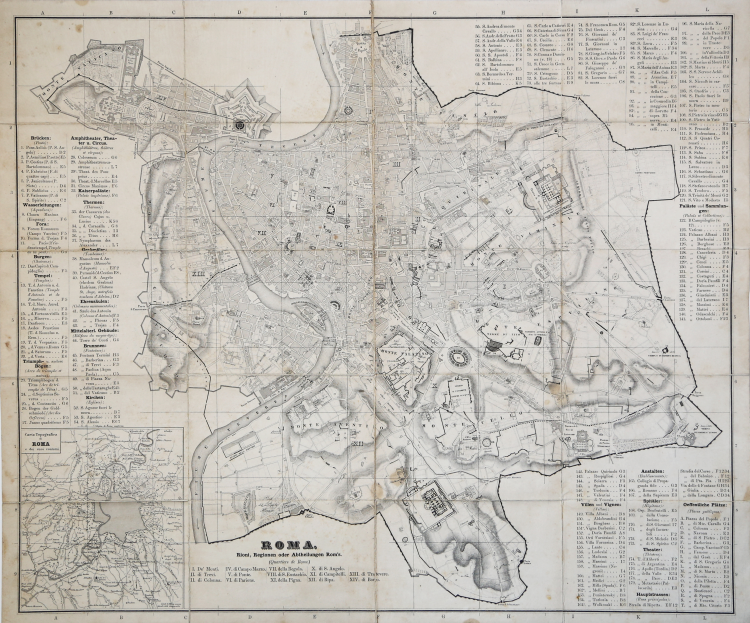



| Reference: | S41653 |
| Author | Ernst Joachim Förster |
| Year: | 1857 |
| Zone: | Rome |
| Printed: | Munich |
| Measures: | 665 x 550 mm |


| Reference: | S41653 |
| Author | Ernst Joachim Förster |
| Year: | 1857 |
| Zone: | Rome |
| Printed: | Munich |
| Measures: | 665 x 550 mm |
Large city plan of Rome titled: Roma. Rioni, Regionen oder Abtheilungen Rom's, with inset map Carta topografica di Roma e dei suoi contorni.
Very detailed, extensive legend listing approx. 200 buildings, monuments and places of interest in Rome.
Overall size 54.5 x 65 cm, image size 52 x 63 cm, multiple horizontal and vertical folds as folded in a book, overall in very good condition.
From: Handbuch für Reisende in Italien von Dr. Ernst Förster, München, Literarisch-Artistische Anstalt, 1857.
Ernst Joachim Förster (8 April 1800 – 29 April 1885)
|
Ernst Joachim Förster was a German painter and an art critic, author of a number of elaborate and important works bearing on the history of art in Germany and Italy.
He was born in Saaleplatte, and initially studied theology and philosophy, but soon devoted himself to art, entering the studio of Peter von Cornelius at Munich. He was employed in painting the frescoes in the Aula at the University of Bonn, and those of the Glyptothek and the arcades at Munich, but his reputation rests chiefly on his discovery of several ancient pictures, and on his works on the history of art. His greatest discovery was the frescoes of Altichiero da Zevio, which date as far back as 1376, in the Chapel of San Giorgio at Padua.
It is known that he lived at Löwen Straße 8 in Munich around 1850. His brother was Friedrich Christoph Förster. He was the son-in-law of Jean Paul, whose works he edited, and whose biography he wrote.
|
Ernst Joachim Förster (8 April 1800 – 29 April 1885)
|
Ernst Joachim Förster was a German painter and an art critic, author of a number of elaborate and important works bearing on the history of art in Germany and Italy.
He was born in Saaleplatte, and initially studied theology and philosophy, but soon devoted himself to art, entering the studio of Peter von Cornelius at Munich. He was employed in painting the frescoes in the Aula at the University of Bonn, and those of the Glyptothek and the arcades at Munich, but his reputation rests chiefly on his discovery of several ancient pictures, and on his works on the history of art. His greatest discovery was the frescoes of Altichiero da Zevio, which date as far back as 1376, in the Chapel of San Giorgio at Padua.
It is known that he lived at Löwen Straße 8 in Munich around 1850. His brother was Friedrich Christoph Förster. He was the son-in-law of Jean Paul, whose works he edited, and whose biography he wrote.
|